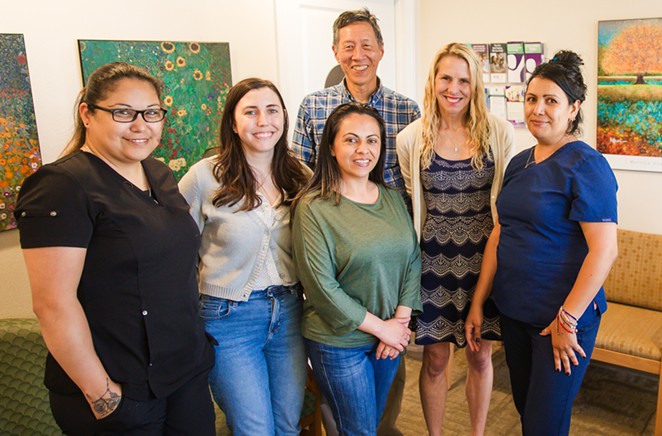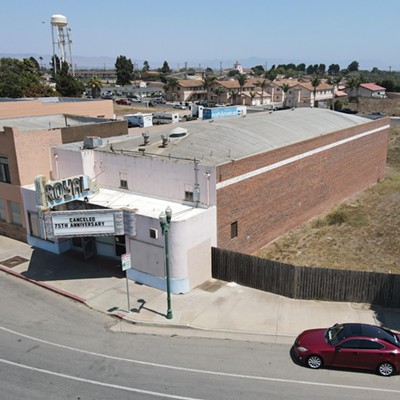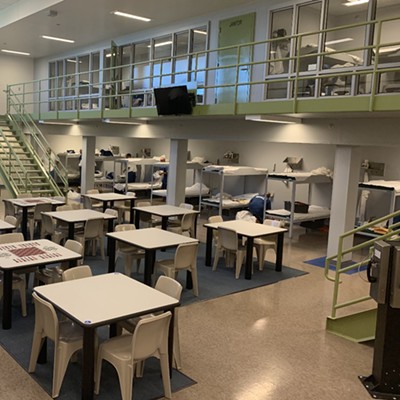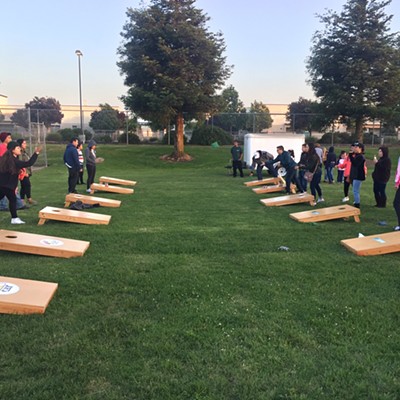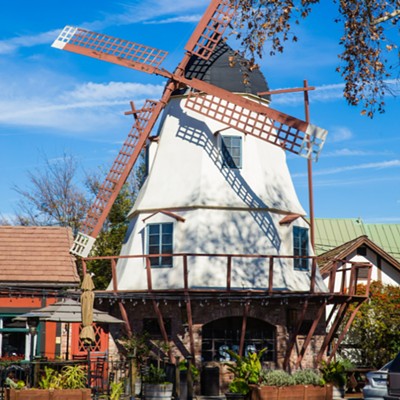After driving three hours from their homes in Lompoc, they met a crowd of picketers surrounding a Los Angeles Planned Parenthood clinic. Kathleen was there with her friend, who was seeking an abortion because the fetus she was carrying wouldn’t survive after birth.
“It had been determined that this child she was carrying was suffering from some neurological issue and if she carried it to term it would live a couple of hours outside her uterus and be in extreme pain,” Kathleen said. “There was no option here, we needed to go ahead with the procedure.”
The two had spent hours in front of their computers, attempting to track down a provider in Lompoc, or the greater Santa Barbara County area, but had no luck. Finally, they got in touch with Planned Parenthood—which told them that the nearest abortion provider was in Los Angeles, said Kathleen, who requested that the Sun only use her first name.
“I didn’t give it a second thought; she was a friend and needed help,” she said. “She could not tell her family about any of this. She was probably 25, 26, just a young woman. She has since married and had another child and moved out of the area.”
When they left the LA clinic, Kathleen drove her car to a back alley to secretly load her friend into the vehicle to avoid any protesters, she said.
“I have no idea if it’s still like that; it may be worse with all of the anti-abortion people being so active,” Kathleen said.
While Kathleen’s experience occurred more than a decade ago, and Planned Parenthood now provides medication abortion and surgical abortions up to 16 weeks in both Santa Barbara and Santa Maria, Lompoc’s still considered a reproductive health care desert.
No health care provider offers abortion services in Santa Barbara County’s third largest city, leaving residents to drive between 40 minutes to an hour for care—or farther away if a procedure is needed beyond 16 weeks.
In an area where residents face higher health inequities due to lower education levels, language and cultural barriers, and institutional barriers, many individuals often don’t trust the current systems in place, said Dr. Melissa Smith, the director of health equity initiatives at UC Santa Barbara. The gaps in services, or cost to travel to a clinic, can cause them to delay needed, preventative care, which can result in detrimental health outcomes that could have otherwise been managed.
Local government officials and Planned Parenthood have been working on establishing a potential partnership for a satellite clinic in Lompoc to provide needed reproductive health care services, but they haven’t identified a partner yet. In the meantime, local providers are working to expand the reproductive health services they do offer, coordinating more outreach efforts to build trust within the community, and enrolling more residents in Medi-Cal, thanks to recent eligibility expansions, in order to provide affordable, comprehensive reproductive health care.
“I think something really needs to be done here in our county, well, nationally actually … to provide these services for women,” Kathleen said. “Here it still feels like an underground movement.”
Unique needs

In January, semi-retired obstetrician-gynecologist (OB-GYN) Dr. Elizabeth Toro began commuting once a month from Santa Barbara to Lompoc to provide reproductive health care services at Savie Health—a Lompoc-based free health care clinic for people who are uninsured and/or low-income.
“For my patients, it’s a big deal for them to get to the clinic. They have to take public transit, take time from their jobs—a lot are domestic workers, so when they show up, they are missing work,” Toro said. “Some of them have not seen a gynecologist for several years so they need a cervical cancer screening or a breast cancer screening. They have reproductive health issues like infections, pelvic pain.”
Reproductive health care encompasses cervical cancer screenings; sexually transmitted infection (STI) tests and treatment; HIV services; mammograms; family planning and contraception methods; pregnancy, prenatal, and postpartum care; emergency contraception (the morning-after pill); abortion services; and menopause care, according to Planned Parenthood.
At Savie Health, Toro typically sees Spanish-speaking women 30 and older and conducts Pap smears, STI tests, and pregnancy tests, and she will discuss any mental health concerns or other preexisting conditions. While the women are older, she will still have conversations about birth control because they’re still exposed to unplanned pregnancies.
“Sometimes certain methods [of birth control] are welcome and others are not an option for them depending on their culture. We have to respect their cultural needs,” she said. “It’s really rewarding, and I kind of hope that physicians [who] are semi-retired or have the time and desire to help out, that this is definitely the way to go.”
Savie’s full reproductive health care services include Pap smears; STI, STD, and HIV/HPV testing; pregnancy tests; and generic birth control pills donated from Direct Relief, a humanitarian aid organization based in Santa Barbara. Savie Health operates Wednesdays to Saturdays from 9 a.m. until 4.p.m.
Savie Executive Director Dr. Eryn Shugart told the Sun that the clinic refers patients to the Santa Barbara County Public Health Department’s Lompoc clinic for mammograms, prenatal and pregnancy care, or a more comprehensive follow-up based on test and Pap smear results.
“Potentially at some point in the future it might be beneficial for us to address maternal health,” Shugart said. “There are farmworkers who feel more comfortable and safe in this clinic; if we could provide some services that would be beneficial.”
Savie Health expanded into reproductive health care services primarily to help migrant farmworkers and those who might be undocumented because the population tends to hesitate when seeking care from public health entities, she said.
“We are free, and the Public Health Department is free, they’re great. They have a sliding scale of services, they provide STD testing and reproductive health like counseling and contraceptives,” Shugart said. “A lot of the group of people are fearful of going to the Public Health Department because it’s the government, and they have the fear of public charge and things that happened with the former administration.”
In 2019, former President Donald Trump signed a proclamation that required all prospective immigrants to prove that they will have U.S. health insurance within 30 days of their arrival or money to pay for “reasonably foreseeable medical costs,” according to Reuters. Trump also often expressed support for limiting immigration, including guest worker visa programs, mass deportations, and ending the Deferred Action for Childhood Arrivals (DACA) program.
“There is a population that feels more comfortable with us than the government,” Shugart said.
Lompoc has more than 44,000 residents, with about 17.2 percent of them living in poverty, compared to 12.2 percent of all California residents, according to U.S. Census data. About 44 percent of the city’s residents speak a language other than English at home, with 41 percent speaking Spanish.
CenCal, the organization that governs and administers Medi-Cal programs in Santa Barbara and SLO counties, serves 13,711 women in the city and a total of 25,625 residents including men and children, CenCal CEO Marina Owen told the Sun.
Countywide, there are more than 32,000 migrant and seasonal agricultural workers, with 3,000 to 4,000 who might be women of reproductive age (between 18 and 49), according to a 2023 UC Santa Barbara and UCLA evaluation report that studied maternal health among farmworkers.
Farmworker women, particularly those who speak indigenous languages such as Mixteco, often don’t feel listened to or understood at health care clinics when seeking maternity care, and they experience discrimination in the health system on the basis of farmworker status, immigration status, language, or indigenous identity, the report found.
“I think there’s very unique health needs [for] people in that migrant farmworker population who are pregnant moms. Because they’re working in fields, they have potential exposure to pesticides, the working conditions, whether they’re able to get time off, have pregnancy-related disability—those are really important factors,” Savie’s Shugart said.
Savie Health had conversations about a potential partnership with Planned Parenthood of California Central Coast to establish a satellite clinic in Lompoc to provide more comprehensive reproductive health care, but more logistical issues need to be worked out before the partnership can be established, Shugart said.
“I believe that it would be beneficial for community members in Lompoc for Planned Parenthood to have a presence,” she said. “I believe that access to women’s health services, more comprehensive women’s health services, in the Lompoc community could only be beneficial for women.”
Addressing health inequities

With a higher percentage of Latino and indigenous residents, lower levels of education, and lack of culturally competent care, North County residents tend to face more upstream factors when it comes to accessing reproductive health care than South County residents, said Smith, the director of health equity initiatives at UC Santa Barbara.
“If you look at communities who have been historically marginalized, they experience multiple forms of marginalization. An indigenous migrant farmworker is more likely to have had less opportunities to access education in her life, hence that speaks to educational barriers and certainly all the social determinants [of health],” Smith said.
Social determinants of health are conditions in the environments where people are born, live, learn, work, and play that affect a wide range of health, functioning, and quality of life outcomes and risks, according to the 2017 to 2021 Santa Barbara County Birth Report analyzing countywide maternal and infant health information.
Determinants can include employment, housing, food security, education access, health insurance and health care access, housing, neighborhood safety, discrimination, and connections to communities—all of which can contribute to wide health disparities and major inequities, according to the report.
“Educational attainment is highly correlated with entry into early prenatal care, and mothers with less than a high school equivalent level of education had lower than average early prenatal care,” according to the report.
About 90 percent of central and South County mothers received a high school equivalent diploma or higher compared to 55 percent of North County mothers. Hispanic females were about 10 percent less likely to start early prenatal care compared to white and Asian females, according to the report.
“We know that early prenatal care is associated with improved birth outcomes,” Smith said. “If you can do an ultrasound in the first trimester, you have a better chance of predicting the gestational age and [identifying] early on any health complications that can impact the health—hypertension, diabetes, previous complications in pregnancy. Being able to screen for any risk factors that can make pregnancy higher risk and implement support systems early on for women.
“When that trust doesn’t exist, when there’s a lack of culturally and linguistically centered care, there are greater chances of women experiencing barriers that can impact their pregnancy and their own birth outcomes,” she added.
According to the birth report, 9.5 percent of Hispanic mothers had a premature birth (less than 37 weeks gestation), compared to 8.6 percent of mothers countywide.
Santa Barbara County also experienced an increase in STIs from 2018 to 2022, with Latino residents as the highest reported race/ethnicity for each STI—early syphilis, chlamydia, gonorrhea, HIV, and MPox—according to a Santa Barbara County STI report. Lompoc in particular reported the second highest five year average HIV rate, with 11 cases per 100,000 population, just behind Santa Barbara city at 13 per 100,000.
Smith said that using a peer education model—like the Promotores Network, where a community member works as a liaison between their communities and public health agencies to provide culturally and linguistically centered education surrounding reproductive health care—could help reduce pregnancy risk, STI rates, and preterm births.
“I think that when we can offer culturally, linguistically centered care to women, in particular in our county indigenous migrant farmworker women, we can create and build trust and make them feel much more comfortable seeking out care,” she said. “Language interpretation and having a support system that is grounded in their culture is a critical factor in women accessing care and understanding the suggested plan of care that a physician might provide.”
Limitations and expansions

The Lompoc Valley Medical Center, the city’s hospital, is a public health care district established in 1946 by the Santa Barbara County Board of Supervisors and is operated by a board of directors, according to its website. Its facilities are regulated, inspected, and certified by the California Department of Public Health and the U.S. Department of Health and Human Services’ Centers for Medicare and Medicaid.
Steve Popkin, the CEO, told the Sun that the facility sees about 350 deliveries per year and offers “comprehensive OB-GYN” services with two OB-GYNs on staff and is expecting a third to join “very soon.” He added that the hospital accepts all types of provider and governmental medical coverage.
“At our Lompoc Health medical clinics, matters of reproductive health are between the patient and her physician; Lompoc Valley Medical Center does not interfere with that relationship,” Popkin said regarding abortion services.
A hospital is required to perform eight basic services: medical, nursing, surgical, anesthesia, radiology, pharmacy, and dietary services, the California Department of Public Health’s Office of Communications told the Sun via email. All other supplemental services, like abortions, are not required by the state.
“While the Local Health Care District Law … does not require a health care district to provide specific services, it does authorize a wide variety of health care services in various types of health care facilities, including hospitals,” the California Department of Public Health communications officials said. “If the stated purpose for the district’s formation and operation is to provide a specific service, then the district hospital is obligated to do so.”
Santa Barbara County Public Health Department’s women’s wellness center in Lompoc sees about 500 patients per month and provides obstetrics and gynecology services, family planning, implant or prescription birth control, mammograms, and follow-up care. However, the facility cannot perform abortion services due to its designation as a federally qualified health center, said Dana Gamble, the Santa Barbara County Public Health Department’s deputy director of primary care and family health.
“What that does for us is it provides a small amount of grant funding, but more importantly it enables us to have a Medi-Cal rate that is slightly higher than non [federally qualified health center] Medi-Cal rate, which allows us to cover more expenses associated with uncompensated care,” Gamble said. “One of the other requirements is we cannot use any federal funding sources for abortion services. … If any patient indicates they’re wanting to learn more about terminating a pregnancy, we refer to Planned Parenthood.”
While the Public Health Department cannot perform abortions, it’s the only Lompoc clinic that accepts presumptive eligibility—temporary, real-time enrollment into Med-Cal. It also provides educational opportunities for staff to address increasing STI rates; conducts follow-ups with patients at their home if they miss an appointment; offers transportation to and from appointments; connects patients to the county’s behavioral health department for any mental health concerns; and uses translation services to ensure linguistically centered care, said Michaela Killer-Westfall, the Lompoc Health Care Center’s administrator.
“We’ve been also trying to offer extended hours because a lot of our patients work and have families to support,” said Killer-Westfall.
With the clinic now scheduled to stay open until 6 p.m., Killer-Westfall said she hopes it will be able to accommodate more patients. The clinic was also scheduled to start having booths at more community events this month to conduct outreach to Lompoc’s indigenous populations.
She added that Gov. Gavin Newsom’s recent expansion of Medi-Cal, which opened up state insurance coverage to undocumented individuals ages 27 to 49, will help more people seek early, preventative care. According to CenCal, the Medi-Cal monitor for the Central Coast, 15,775 new patients enrolled in Santa Barbara County, including 971 in Lompoc.
Maria Gardner, the assistant director for the Department of Social Services, added that there are about 400 uninsured females in Lompoc potentially eligible for Medi-Cal.
Killer-Westfall said that the new eligibility will hopefully help more people seek preventative care rather than waiting until it’s an emergency.
“When they don’t have to choose between food, housing, and health care, they are more likely to come in for preventative care, ongoing access to health care, not when it was emergent or urgent,” Killer-Westfall said.
Partnership challenges

Minimal reproductive health care access came before Santa Barbara County 3rd District Supervisor Joan Hartmann’s office when she took over as Lompoc’s supervisor in 2022 after redistricting, said Gina Fischer, Hartmann’s chief of staff.
“Constituents in Lompoc brought forward to us questions and concerns about the lack of access to reproductive care specifically, which aligned with my experience as previously working in the arena of reproductive health care,” Fischer said. “We have played a role in our office [by] trying to connect partners who could enhance the landscape of what reproductive care is offered in Lompoc directly.”
While Hartmann’s office worked to connect different local health care providers with Planned Parenthood to establish a clinic, it’s been difficult finding a match, Fischer said.
“Drawing on my experience having worked in this field prior to working for Supervisor Hartmann, facilitating these types of partnerships can be challenging because of the unfair stigma that some providers of reproductive health care have by folks who identify as anti-abortion,” she said.
Santa Barbara County’s redistricting map took effect at the same time the U.S. Supreme Court overturned Roe v. Wade, a 1973 landmark decision that gave women the constitutional protection to access abortion. The overturn resulted in a wave of abortion restrictions in several states.
“We just try to normalize the landscape of reproductive health care and that health care, including … safe abortion access is a human right. That’s something we fundamentally believe in,” Fischer said. “A lack of any access, timely access, to health care—any health care delivered—in someone’s community negatively impacts one’s quality of life.”
Luz Reyes-Martín, the vice president of advocacy and engagement of Planned Parenthood California Central Coast, told the Sun that the nonprofit continues to have conversations with other health care providers and remains open to the satellite clinic.
“There’s not one single way of what that could look like,” Reyes-Martín said. “Perhaps we could come in on some schedule once a week or a few times a month to do medication abortion or appointments for family planning. … We would want to tailor something that would work for the community, for staff, for us, and what would work for that partner.”
Planned Parenthood conducted similar work in neighboring Ventura County, where the nonprofit recently established a clinic in Oxnard. While it’s not rural, Planned Parenthood was interested in bringing more services to the 200,000-person city, she said. A community-needs survey showed existing health care gaps and a patient volume Planned Parenthood could serve, resulting in the facility’s opening in 2021, she said.
“We have an existing center in Ventura, which is very much close by, but recognizing it as a very large city it was always an interest for us to have a health center there,” Reyes-Martín said. “We’ve definitely served a big part of that community. I think others might have gone to Ventura, but it’s more convenient to stay in Oxnard. It’s such a large city where it makes sense to have a health center there, and it’s been very successful.”
In Santa Barbara County, Planned Parenthood has one clinic in Santa Maria and one in Santa Barbara, which served 633 unique patients from Lompoc during the 2023 calendar year, Reyes-Martín said. From SLO to Ventura counties, Planned Parenthood serves more than 30,000 patients annually.
“The big picture is we’re always looking at our service area and where our patients are coming from. Lompoc is one of several rural parts in our service area; we are always looking at ways to enhance or expand the services we provide,” Reyes-Martín said.
“We know folks need more options [for] care; our doors will be open to them.”
Reach Staff Writer Taylor O’Connor at [email protected].


